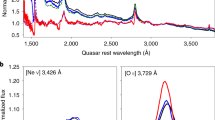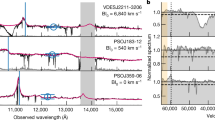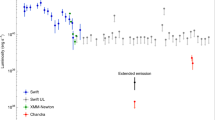Abstract
Recently, Mathews has proposed1 a mechanism for the mass supply to a black hole in the centre of a quasar (see also ref. 2). According to this proposal the X rays from the central source penetrate the photosphere surrounding low-mass stars. The absorbed energy is distributed over the stellar interior by convection, and the star expands rapidly. Its outer layers are then stripped by the radiation field of the central source. There are two major uncertainties in this model of reversed evolution; the depth to which the X rays impinging on a low-mass star can penetrate before they are absorbed and the inward transport of the energy flux. The crucial hypothesis of Mathews is that the X rays are absorbed within the convection zone. We now test this hypothesis by considering the effects of X-ray absorption in the secondaries of low-mass X-ray binaries. We conclude that reverse evolution does not occur.
This is a preview of subscription content, access via your institution
Access options
Subscribe to this journal
Receive 51 print issues and online access
$199.00 per year
only $3.90 per issue
Buy this article
- Purchase on Springer Link
- Instant access to full article PDF
Prices may be subject to local taxes which are calculated during checkout
Similar content being viewed by others
References
Mathews, W. G. Astrophys. J. 272, 390–399 (1983).
Gaskell, M. Nature 307, 210 (1984).
Joss, P. C. & Rappaport, S. Astr. Astrophys. 71, 217–220 (1979).
Milgrom, M. Astr. Astrophys. 67, L25–L28 (1978).
Van Paradijs, J. in Accretion-driven Stellar X-ray Sources (eds Lewin, W. H. G. & van den Heuvel, E. P. J.), 189 (Cambridge University Press, 1983).
Cominsky, L. R. & Wood, K. S. Preprint (Naval Research Laboratory, Washington, DC, 1984).
Middleditch, J., Nelson, J., Mason, K. O. & White, N. Astrophys. J. 244, 1001–1021 (1981).
Paczynski, B. Acta astr. 17, 287–296 (1967).
Katz, J. I. Nature 253, 698–699 (1975).
Fabian, A. C., Pringle, J. E. & Rees, M. J. Mon. Not. astr. Soc. 172, 15p–18p (1975).
Author information
Authors and Affiliations
Rights and permissions
About this article
Cite this article
Verbunt, F., Fabian, A. & Rees, M. Reverse stellar evolution, quasars and low-mass X-ray binaries. Nature 309, 331–332 (1984). https://doi.org/10.1038/309331a0
Received:
Accepted:
Issue Date:
DOI: https://doi.org/10.1038/309331a0
Comments
By submitting a comment you agree to abide by our Terms and Community Guidelines. If you find something abusive or that does not comply with our terms or guidelines please flag it as inappropriate.



